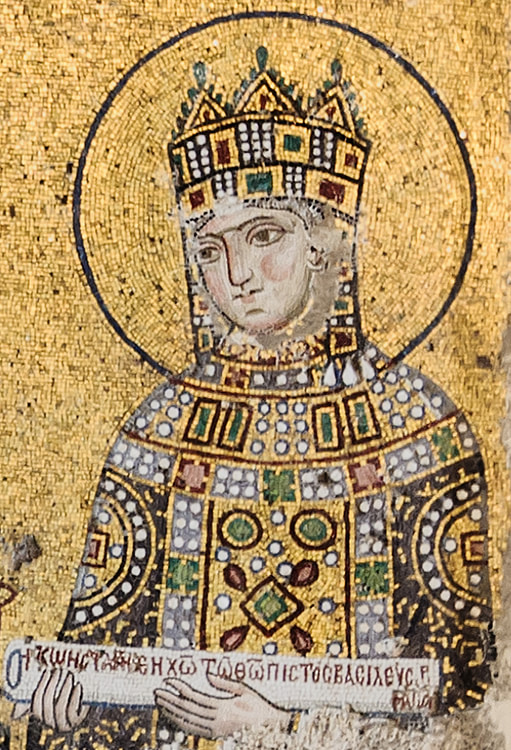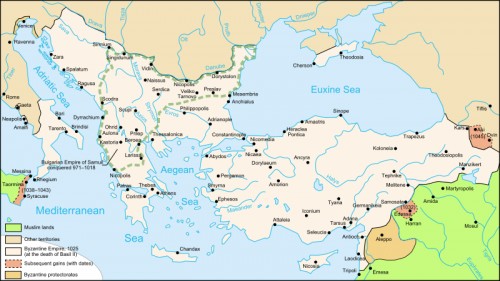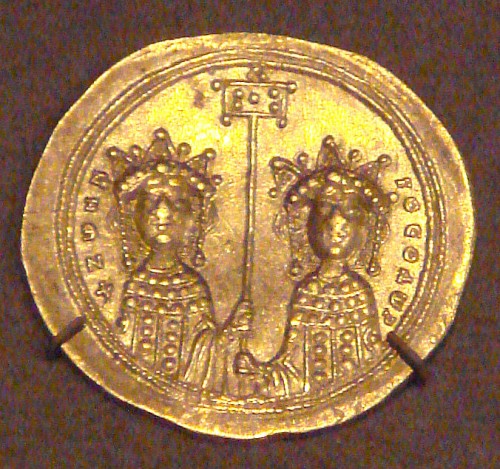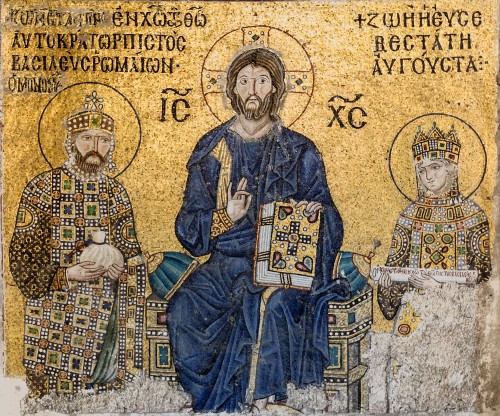Empress Zoe › The Archaeological Excavations at Magdala » Origins and History
Articles and Definitions › Contents
- Empress Zoe › Who Was
- The Archaeological Excavations at Magdala › Antique Origins
Ancient civilizations › Historical places, and their characters
Empress Zoe › Who Was
Definition and Origins

Zoe Porphyrogenita was empress of the Byzantine Empire from 1028 CE until her death in 1050 CE. In an eventful career, she reigned alongside three husbands, had a hand in the succession of her adopted son, and, in 1042 CE, she was co-ruler with her sister Theodora. Zoe is the subject of a colourful and somewhat unflattering biography in the Chronographia of the 11th-century CE Byzantine historian Michael Psellos.
EARLY LIFE
Zoe was born c. 978 CE, one of three daughters of Constantine VIII (r. 1025-1028 CE). She first appears on the stage of history when her uncle emperor Basil II (r. 976-1025 CE) promised her in a marriage of alliance to Otto III (r. 996-1002 CE), the Holy Roman Emperor. Zoe, then 23 and said to have been a great beauty, set sail in 1001 CE from Constantinople, but on arrival at Bari, she was given the sad news that Otto had died of fever. It was one of those moments in history of “what might have been?”, if the imperial families of the two great empires of the west had been united. Instead, Zoe returned home to spend the next 27 years in the seclusion of the Great Palace of Constantinople, but her time would come.
Zoe's character and physique is described in the following terms by the oft-critical Byzantine historian and courtier Michael Psellos (1018 - c. 1082 CE), who had seen the empress with his own eyes when she was in old age:
[Zoe] was regal in her ways, a woman of great beauty, most imposing in her manner and commanding respect…was a woman of passionate interests, prepared with equal enthusiasm for both alternatives, death or life, I mean.In that she reminded me of sea-waves, now lifting a ship on high and then again plunging it down to the depths…Zoe was openhanded, the sort of woman who could exhaust a sea teaming with gold -dust in one day…[she] confused the trifles of the harem with important matters of state…Her eyes were large, set wide apart with imposing eyebrows. Her nose was inclined to be aquiline, and her whole body was radiant with the whitness of her skin ( Zoe & Theodora, Chronographia )
ROMANOS III (HUSBAND NO. 1)
When her father Constantine VIII died of old age without having produced a male heir, Zoe became empress in 1028 CE, her elder sister having long since taken up residence in a monastery. Constantine had prearranged the marriage of Zoe to the aged Romanos Argyrus, the eparch (in effect, mayor) of Constantinople who, now made emperor, became Romanos III. Not at all interested in her father's choice, Zoe conspired with her teenage lover Michael to assassinate Romanos who had taken a mistress of his own and rather unwisely refused Zoe access to the imperial treasury. The emperor was drowned in his bath in 1034 CE. Romanos had not been at all popular with very many other people, either. His reign was seen as a disaster for the Byzantine economy - particularly his policy of cutting taxes for the landed aristocracy and lavishly spending what he could not afford on churches and monasteries. Military matters were no more successful with the low point being a defeat by an Arab army at Aleppo in 1030 CE.

Byzantine Empire, 1025 CE
MICHAEL IV (HUSBAND NO. 2)
Michael thus became emperor in 1034 CE as Michael IV Paphlagon, but he turned out to be something of a schemer himself and promptly had Zoe, now 56, banished to a monastery. Michael's reign was no more successful than his predecessor's with the aristocracy opposed to the undue influence at court of the eunuch John the Orphanotrophos, the brother of Michael IV. A major revolt was led by Peter Deljan over the high rate of taxation and John's unreasonable demand that taxes be paid in cash and not the usual payment in kind. The revolt broke out in 1040 CE, but the tax issue was really only a spark for the real burning issue: the Byzantine domination of the Bulgars. Deljan claimed to be the son (or grandson) of the ex-Tsar Samuel of Bulgaria and the rebels rocked the empire by capturing such important cities as Belgrade, Nish, and Skopje, even unsuccessfully besieging the second most important Byzantine city, Thessalonica. Within a year, though, Deljan was betrayed by his co-rebel ruler Alousianos (son of the present Bulgar Tsar John Vladislav), who gave up his partner to Michael, and the rebellion was quashed.
THE PEOPLE OF CONSTANTINOPLE & THE CHURCH ALWAYS FAVOURED ZOE AS SHE REPRESENTED THE TRUE DYNASTIC LINE.
There were other rebellions besides Deljan's to deal with. Stefan Vojislav, the Prince of Zeta, (aka Duklja in Serbia) had led a revolt in 1034 CE and gained independence for Zeta by winning a battle in the Dyrrachion province in 1042 CE. As with Romanos' reign, defeats abroad contributed to a general feeling of decline as the fringes of the empire continued to be nibbled at by foreign powers. In Michael's case, the losses came in Sicily, which were in no small part due to the emperor being stupid enough to recall his brilliant general George Maniakes from the island and put him in prison in 1040 CE. On top of all these troubles, Michael suffered from epilepsy which was worsening with age even if he was still only in his twenties.
MICHAEL V (THE NEPHEW)
Meanwhile, Zoe may have been removed to a monastery but she was not quite out of the way, and she remained ambitious to regain her throne. She had been encouraged to adopt as her son Michael V, the nephew of Michael IV, by John the Orphanotrophos. John, seeing that his brother was dying, was eager to maintain his powerful position at court by adopting a new protege. Zoe could use the same tool to get back to her rightful position at court. The ailing Michael IV was thus forced to retire to a monastery in 1041 CE where he died of natural causes.

Gold Coin depicting Zoe and Theodora
Michael V Kalaphates was so called because his father was a mere caulker while his mother was the sister of Michael IV. Zoe was obliged to make Michael V the official heir to the throne, but when he became emperor in 1041 CE, he turned on those who had set him up as ruler and banished John the Orphanotrophos from court. Zoe was next in April 1042 CE, when the empress was sent to a monastery for a second time (on Prinkipo, a Marmara island). However, the people of Constantinople and the church favoured Zoe as she represented the true dynastic line. A popular revolt sprang up and a mob trashed the palace and overthrew the young emperor in April 1042 CE. Zoe then co-ruled with her younger sister Theodora, who was also brought out of her retirement in a monastery. The Byzantines now had two old ladies sharing the throne, but at least they had an impeccable imperial pedigree, and the despicable Michael was banished to a monastery. For the people, this light punishment was not enough, though, and so Zoe ordered that he be blinded.
CONSTANTINE IX (HUSBAND NO. 3)
Zoe, no doubt because of her age (then 64 years old) and previous experience, was given precedence over her sister - her throne, for example, was set slightly further forward than Theodora's at their re-coronation ceremony. Hoping to start a new chapter of Byzantine history, the sisters made new court appointments, ruled against corrupt practices like selling titles, and instigated an enquiry into the transgressions of their predecessor.
Zoe cemented her position by choosing a new husband, her third. Constantine Monomachos was a rich and elegant choice, long-admired by the empress, and so he was recalled from his exile on Lesbos. Married in June 1042 CE, the aristocrat with an outrageous reputation as a ladies' man became emperor Constantine IX Monomachos (r. 1042-1055 CE). Constantine did have experience of Byzantine government as he had been a senior civil administrator, and he had some pedigree, being related to Romanos III.

Constantine IX & Empress Zoe
In an unprecedented arrangement, Constantine co-ruled with Zoe and Theodora. To complicate matters even further, Constantine installed his long-time lover Sclerina in the palace, a move seemingly blessed by Zoe. The public was not quite so tolerant of this confusing division of power and called for Sclerina's removal - a quandary solved by her sudden death from a pulmonary disease.
One of the new emperor's first acts was to banish the scheming John from court for a second time in his career, punishing him with the all-too-frequent Byzantine mutilation of blinding. Constantine set about reforming the administration of the empire, but this contributed to two major revolts led by the generals George Maniakes and Leo Tornikios (the emperor's nephew) in 1043 CE and 1047 CE respectively. The emperor surrounded himself at court with noted intellectuals, Michael Psellos amongst them but his neglect of the army had long-term consequences, even if a Rus attack on Constantinople was thwarted in 1043 CE. The empire was crumbling at the frontiers with the Normans making inroads into southern Italy, the Pechenegs threatening the Balkans, and the Seljuks expanding in Asia Minor. Constantine might have skimped on the army but he still found resources to build lavish monasteries and give gifts to his aristocratic cronies.
DEATH
In 1050 CE, as the Empire was experiencing some of its darkest days, Zoe died. Despite three marriages, she had never had a child, and when her sister Theodora died in 1056 CE, so the Macedonian dynasty founded by Basil I (r. 867-886 CE) died out. Zoe lives on, though, in popular memory thanks to her colourful life, the biography by Psellos and the famous gold and glass mosaic of the Hagia Sophia in Constantinople. Here the Empress is portrayed alongside Constantine IX with Jesus Christ between them in an act of blessing. Situated on the east wall of the south gallery, each gives donations to Christ, and Zoe wears a stunning jewelled-robe and crown. Above her is an inscription which reads “Zoe, the most pious Augusta”. The mosaic interestingly reflects Zoe's turbulent personal life because on close inspection one can see that the heads of all three figures have been altered as the original mosaic perhaps honoured Zoe's first husband Romanos III or even her nephew Michael V.
The Archaeological Excavations at Magdala › Antique Origins
Ancient Civilizations
Magdala, known as Migdal in Hebrew (מִגְדָּל: tower) and also as Taricheae (Ταριχέα, from the Greek Τάριχος or tarichos : preserved by salting or drying fish), was an important fishing town during the first century CE on the western shore of the Sea of Galilee and below Mount Arbel. According to biblical references, it was the hometown of Mary Magdalene and historical sources such as Flavio Josephus, Strabo, Pliny the Edler, Cicero, and Suetonius mention the importance of this town because of its excellent salted fish and important Roman markets.
GEOGRAPHICAL LOCATION
Magdala Taricheae is located in the Lower Galilee, a region in the north of Israel. Galilee is divided into Upper and Lower Galilee, Upper Galilee is to the north of Israel, currently on the border with Lebanon. It is a mountainous and forested area.During the first century CE, the settlements of Meron, Gush Halay, Nabratein, Gamla, Hazor, Zefat were developed.

Magdala Synagogue
The Lower Galilee “is a series of valleys and ridges ascending gradually from the western coastal plain into the interior, the dropping dramatically in elevation to the Jordan Valley and the lake (Sea of Galilee) in the east.” (Horsely, 20). This topographical division also allowed a political and economic division in the area. Some settlements developed during the first century CE in this region were Sepphoris, Nazareth, ("Tiberias"), Magdala, Capernaum, and Yodfat.
It is in this prosperous region (Lower Galilee) that Magdala developed during the first century CE. It is located 3 miles north of Tiberias which was founded by Herod Antipas between the years 17 and 20 CE to make it the capital of Galilee instead of Sepphoris, and 6 miles south of Capernaum, a fishing village traditionally known as the center of Jesus ' public ministry, and where the house of Peter his apostle was located.
MAGDALA THROUGH HISTORY
According to historical sources and archaeological facts, Magdala was an important town with social and economic development. As a result of this progress, there was a "synagogue" with mosaic floors and walls decorated with stucco, dated to the first century; ritual baths ( miqva'ot, in plural) with water flowing from an underground system; mosaic and basalt floor rooms, and courtyards.
FISHING & SALTING FISH WERE THE MAIN ACTIVITIES OF THE TOWN, INDUSTRIES WHICH TOOK PLACE IN THE HARBOR & MARKETPLACE AREA.
Fishing and salting fish were the main activities of the town, industries which took place in the harbor and marketplace area.The marketplace next to the harbor had a beautiful stone slab floor with rooms along the sides, possibly used for commerce and production activities. This area was the heart of Magdala's trade.
During the Second Temple in the 1st CE, “Galilee plays a major role in various historical surveys of the Great Revolt against Rome in 66 – 70 CE.” (Rapport, 95). Flavius Josephus, a historical source from the first century wrote about the first revolt against Rome in his book The Jewish War where it mentions the Roman attack over Magdala Taricheae in year 67 CE. The Jewish rebels defended Magdala in the vicinity of Mount Arbel and defended the wall that surrounded the town, but they could not stop the entrance of Vespasian ’s legion, led by his son Titus, into Magdala. A massacre of the town's residence then followed. Josephus wrote about Magdala's destruction in this revolt, but until now the archaeological findings do not give information regarding how complete was the destruction.

Miqva'ot in Magdala
The current archaeological findings such as ("coins"), pottery, and glass, indicate that the chronology of Magdala began in the Hellenistic period and continued until the middle Roman period. According to historical sources, during the 4th century CE Saint Helena, mother of "Emperor" Constantine the Great arrived at the ruins of ancient Magdala and built a basilica over what she believed was the house of Mary Magdalene according to what local people said during her quest of the holy places.She was one of the first pilgrims in the Holy Land who built churches and basilicas in places which tradition declared as holy.
Between the 4th and 6th century CE, different pilgrims wrote about these holy sites, such as Egeriae in her book: Itinerarium Egeriae ; and Theodosius who made a list and description of the holy places known in those days, in his list Magdala is mentioned. However, we must bear in mind that in the case of Magdala, there is still no scientific evidence of its location as described in the accounts of these first pilgrims.
EARLY ARCHAEOLOGICAL EXPLORATION
In the mid and late 19th century CE, British and North American explorations took place in the Holy Land with the objective of finding and registering all the relevant historical places that once were described by Flavius Josephus and pilgrims of later centuries.
* The Palestine Exploration Fund. - Distinguished academics and clerics who worked to promote and make historical, archaeological, topographic, cultural, geological and natural investigations of Biblical Palestine. This project was under the royal patronage of Queen Victoria.
* The American Colony. – This was an American Christian community formed in Jerusalem. Was commissioned to document through photographs and texts all the historical sites of the Holy Land, including Magdala.

Magdala Ritual Area
The Franciscan Custody of the Holy Land has owned one part of the Magdala ancient town since 1912 CE. Between 1971 and 1977 CE archaeological excavations began, conducted by Father Stephano Loffreda and Father Virgilio Canio Corbo, when structures, streets and artefacts (1st BCE – 4th CE) were brought to the light. Through these excavations, it was possible to identify the foundation of Magdala Taricheae in the late Hellenistic period. It was the first time that Magdala was archaeologically assessed.
ARCHAEOLOGICAL DISCOVERIES IN MAGDALA
In the year 2002 CE, the Israel Antiquity Authorities (IAA) made some test pits at the south and north of the Franciscan area at Magdala; and the Franciscan Custody again took up archaeological activities in 2007 and 2008 CE led by F. Stefano de Luca.In 2009 CE the ancient synagogue of Magdala was discovered by the archaeologists Dina Avshalom-Gorni and Arfan Naijar from the Israel Antiquity Authorities, at the north of the Franciscan area.
A STONE BLOCK DISCOVERED AT MAGDALA HAS A RELIEF OF ONE OF THE EARLIEST REPRESENTATIONS OF A SEVEN-BRANCHED MENORAH OVER A PEDESTAL.
The synagogue dates from the 1st century according to the archaeological findings such as coins and pottery fragments. So far, it is the only synagogue of this time that has a mosaic floor and walls decorated with colored frescoes: red, yellow, blue, black and white.
In the main room surrounded by stone-benches, found in one of the corners, there is a particular carved rectangular stone below a collapsed column. It looked as if this stone was placed there on purpose to hide it. This unique stone has relief decoration on its four sides and the top of it. On the front side is the relief of one of the earliest representations of a seven-branched menorah over a pedestal; on the two longer sides the reliefs of pillared archways; on the top surface is carved a large six-petal rosette flower flanked by two palm trees on the sides. The rosette is a symbol that is repeated in the mosaic of the synagogue and the ritual baths area. This unique stone “was apparently used as a base for reading table supporting the Torah scrolls.” (M. Zapata and R. Sanz, 41).

Magdala Stone
To the south of the synagogue a building was found which by its characteristics refers to a market and a production area. On one side of this building, facing the synagogue, water installations were discovered that were used to contained clean water, because according to the soil sample analysis there is no evidence of any chemical residue found inside the pools. On the west side of the building is a street with a basalt sidewalk and entrances to different market and production rooms which have coarse pottery ovens.
The Israel Antiquity Authority in 2010 and 2011 CE also excavated one part of Magdala's harbor which has a main street made of basalt and limestone stones, and the market area next to the lake. At an average distance of 260 m is the continuation of this harbor into the Franciscan area in which is evidence of the anchorage place where boats used to be anchored before and after their fishing and trade activities in the Galilee Sea.
From 2010 to 2011 CE archaeological excavations led by the archaeologist Marcela Zapata Meza from the Universidad Anáhuac México brought to light the discovery of the first ritual baths ( miqva'ot) next to the Sea of Galilee fed by underground water. These miqva'ot are unique in all Israel because of the location and hydraulic and construction system. In antiquity, the lake waters were used for ritual purification, so it was believed that there was no sense of having a miqveh (ritual bath in singular); until now
The ritual area is composed (so far) of two buildings divided by a street. Each building has two stepped miqva'ot formed with basalt stones, and rooms with basalt floors for immersion preparation. One of these rooms has a polychrome mosaic floor (white, black, red) decorated with a rosette of eight petals (like the one in the synagogue) inside a rhombus.

Mosaic floor in Magdala
At the east side of this area another building was discovered in which were found fishing tools such as lead weights and bronze hooks. According to the archaeological evidence, this building has a very basic construction system, most of its building stones have a rough finish compared to the ritual area construction.
52 meters to the east from this area is another building with a better constructive system. In this building grinding stones were found in situ, ovens made with coarse pottery, courtyards and stone paved rooms. The archaeological findings suggest that it was a domestic and production area.
INTERPRETATIONS OF MAGDALA
With the archaeological evidence found so far at Magdala it is clear the twon was a wealthy Jewish town in the Lower Galilee - no other town has this kind of miqva'ot, a synagogue with mosaic floors, or a complex hydraulic system with underwater flowing through the channels. Besides being known as an important place for salting fish and its relation to the Roman markets, now we know that the purity and ritual activities were an important factor in the daily life of Magdala inhabitants.
Around 2,500 coins have been found, mainly bronze from the 1st and 2nd century CE. So far the continuity of the coins' chronology, pottery analysis, and the architectural structures can all give us an idea that Magdala was not completely destroyed as Josephus wrote in his book thousands of years ago, it could well have endured major changes after the revolt but life continued in Magdala for many more years after.
LICENSE:
Article based on information obtained from these sources:with permission from the Website Ancient History Encyclopedia
Content is available under License Creative Commons: Attribution-NonCommercial-ShareAlike 3.0 Unported. CC-BY-NC-SA License